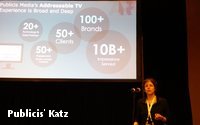 Among some
important new research and insights unveiled during the Advertising Research Foundation’s annual Audience Measurement Conference in New York this week was one breakout session that may not have
gotten as much attention as the main stage acts, but it represents a significant leap forward in understanding the value of addressable TV advertising. And in some ways, it also represents a nod
backward to some of the most fundamental precepts of TV market planning.
Among some
important new research and insights unveiled during the Advertising Research Foundation’s annual Audience Measurement Conference in New York this week was one breakout session that may not have
gotten as much attention as the main stage acts, but it represents a significant leap forward in understanding the value of addressable TV advertising. And in some ways, it also represents a nod
backward to some of the most fundamental precepts of TV market planning.
The research, presented by Publicis Media’s Helen Katz and a team from Nielsen Catalina Solutions, may
be the first of its kind to control for the performance of two simultaneous addressable TV campaigns deployed in the marketplace at the same time targeting two distinct groups of consumers: One
comprised of consumers known to buy a specific brand and another comprised of consumers know to buy brands in the same category.
advertisement
advertisement
Katz said the fact that two disparate campaigns,
across separate addressable TV platforms for the same (undisclosed) Publicis client were in the market at the same time, presented her research team with a unique opportunity to effectively test what
happens when you target consumers on the basis of brand vs. category.
Katz, who noted that Publicis has been testing addressable TV ad campaigns for more than a decade and has served
more than 10 billion addressable TV ad impressions to date, said despite all that learning, the industry still doesn’t understand the full power of targeting consumers on brand vs. category
bases. Until now.
“Should I be targeting just my brand buyers, or should I go broader and target the whole category?” she asked ARF attendees while presenting the
findings earlier this week, adding: “We were able to answer this question.”
The answer: Targeting brand buyers explicitly generates much higher sales lift, but not as
much incremental revenue because it inherently is a smaller, more targeted audience.
Both campaigns were proven to generate significant incremental sales lift, but the one targeted
at brand buyers generated significantly more: 29% vs. only 19% for the campaign targeted at category buyers.
On a cost-efficiency basis, the brand buyer-targeted campaign also
outperformed the category buyer targeted campaign, generating an incremental sales return of $0.75 per household reached, vs. only $0.55 for the category buyer households reached.
But because there are more category households in the universe Publicis was targeting than households specifically buying that brand, the overall reach of the category targeted campaign
generate more incremental sales: $1,061,395 vs. $734,884 for the brand buyer targeted campaign.
Katz said the study represents an important benchmark for agencies and brands to
understand the value of targeting audiences with the precision of addressability, but more work needs to be done to refine best practices.
The study is interesting for another
reason, because targeting brand users vs. category users is one of the seminal ways brands and agencies have planned -- and allocated budgets -- historically in spot TV advertising markets, which
prior to addressability, had been the standard for many brands to determine how much media weight they put against markets.
In the parlance of spot TV buying, the industry called
this approach either “brand development index” or “category development index,” and developed rules of thumb for understanding which approach would yield better returns for
budgeting spot TV advertising in a TV marketplace.
Asked whether there was any correlation between the Publicis / Nielsen Catalina Solutions addressable TV ad test and historical
spot TV “BDI” and “CDI” planning, NCS Chief Research Officer Leslie Wood said she didn’t know but would look into it.
“It’s a good question,”
concluded Publicis’ Katz.
